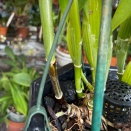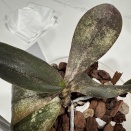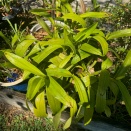Orchid Culture - Questions & Answers from This Month
If you like what you see, feel free to leave a donation; just click on the Tip Jar. Thank you!by Sue Bottom, from the St. Augustine Orchid Society Newsletter. Email us with any orchid question. If we can't answer it, we'll find someone who can! Send photographs too!
Black But Hard Cattleya Pseudobulb
Q. I just noticed this black at the base of my cattleya. The pseudobulb is hard, not rotten. I guess it’s best to chop it off so it doesn't spread?A. That looks an awful lot like the fast moving black rot coming up from the roots into the pseudobulb and next through the rhizome into the other pseudobulbs. Cut, sterilize and keep cutting until you don't see any more discoloration in the rhizome. You can treat with something like Banrot, Subdue or Aliette if you have them, and then keep it on the dry side for a couple days. (Dec-25)
Mites on Phal
Q. I’ve been dealing with I think spider mites for the past year or so. I don’t see anything and there’s no webbing but I will see something that looks like rust if I wipe under the leaves. This is only on my phalaenopsis growing in the house under lights. I would appreciate any help you can give me.A. That sure looks like mite damage, they thrive in the dry environment under lights. You don't always see webbing, but the stippling on the upper leaf surface and the poop you see when you wipe the leaves are indicative of mites. If you get a loupe or a magnifier, you should be able to see them crawling around on the leaf underside. I use Avid for mites, you can get a generic abamectin that is a little cheaper. You'll spray thoroughly the upper and lower leaf surfaces at weekly intervals for a month. While you are waiting for the chemical to arrive, you can take the phal to the kitchen sink and wash it using dish detergent rubbing the leaves top and bottom. Then start your spraying program. You might also consider spraying everything that's under lights cause the mites will travel from plant to plant. (Dec-25)
Black Sunken Spots on Schombocatt
Q. This plant is important to me. I left for three weeks and when I came back, many of the leaves had these spots, which go right through the leaf. What shall I do?A. That looks like a schombocatt and they're pretty tough customers, but you don't know how fast the damage occurred or whether it was concurrent with excess leaf wetness. I'm debating whether it's a bacterial problem, which is what the damage on the leaf tips looks like, or anthracnose, which is what the damage close to the leaf axil looks like. I think I would cut away the severely damaged leaves and spray the plant with copper and see if that doesn't stop any further damage. Mary cut off lots of leaf tips but decided to leave some of the leaves with minimal damage, and sprayed with a copper fungicide/bactericide. (Dec-25)





